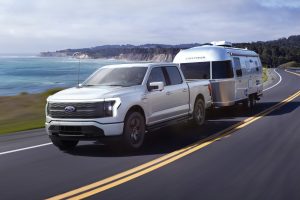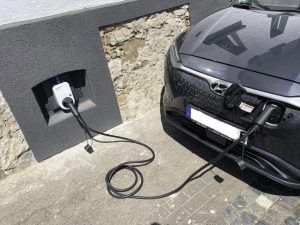Change is hard.
Abandoning a way of life is difficult and we would be lying to claim that everyone at NE Clean Energy commutes to work with an EV. However, we believe in taking the first step to at least challenge your perception of the accessibility of an EV and how much converting would be beneficial in the long run for you financially, as well as your carbon footprint.
 EV’s are becoming more common as manufacturers explore bringing more green features to their vehicles of all classifications. Some notable examples include the Ford F150 Lightning, Rivian R1T, Ford Transit Electric, and the Tesla Cybertruck.
EV’s are becoming more common as manufacturers explore bringing more green features to their vehicles of all classifications. Some notable examples include the Ford F150 Lightning, Rivian R1T, Ford Transit Electric, and the Tesla Cybertruck.
Even companies who are not quite ready to fully give up on fossil fuels are incorporating electric charging as at least an option. In fact, electric car sales increased 60% to almost 160,000 in Q1 2022 in the U.S.
So why aren’t EVs more popular?
While recording 4.6% market share for vehicles nationwide, we believe EVs are not living up to their potential due to 4 reasons: constantly-changing information, range anxiety, lack of competition, and cost.
Changing Information: It is easy to be overwhelmed by information on EVs, but the truth is that it’s relatively simple. Instead of having a fuel tank, your car now has a battery and instead of needing to find a gas station, you’ll be looking for a charging port. Or you can charge up at home with solar panels by installing your very own charging system (more on this later).
Range Anxiety: The fear of running out of power and not finding a charging station is real, but the realization of that fear is less and less likely due to the drastic improvements in range and charging infrastructure. The typical EV supports distances of 200 to 450 miles on a single charge. This is a big improvement on the 100 miles limitation that used to plague early EV models.
Lack of Competition and Cost: Unfortunately, we live in a Tesla-dominated market. The term EV is almost synonymous with a Tesla vehicle and while the Model S is brilliant, Tesla owning a 71% share of the market is not good for the customer. The cheapest Tesla Model 3 goes for around $50,000 before taxes and not including all the bells and whistles.
The good news is that other manufacturers such as KIA, Ford, Hyundai, Nissan, Honda, and GMC all are offering – or will soon offer – multiple EVs. For example, Honda plans to release 15 EV models by 2025, and Nissan is working on delivering 23 EVs by 2030.
Other noteworthy developments include Honda and General Motors announcing a joint venture to produce EVs for less than $30,000 by 2027.
But where does your home with solar panels factor into all of this?
Electric cars are rated by the EPA on a kWh (kilowatt-hours) requirement basis for a 100 miles drive which can be converted to a miles-per-gallon equivalent (MPGe). Armed with this knowledge, you can easily calculate the “extra” amount of electricity you will need to cover transportation costs.
For example, the Tesla Model Y is the best selling EV with 172,700 units sold and has a combined fuel economy rating of 27 kWh/100 mi. If an average American travels 25 miles per day, their home with solar panels will need to support an additional 6.75 kWh of electricity per day or approximately 2,465 kWh per year.
As a general guideline, a typical New England Clean Energy installed system on a typical residential home will produce about 9,600 kWh per year. What this ultimately means is that depending on a multitude of factors including your transportation needs and current electricity usage habits, expect your EV to consume about one fourth of that production.
The EV leap of faith and concluding words…
In short, EVs are definitely coming and they will prevail. But there are clearly issues.
For one, the average American home has 2 vehicles which will mean solar systems will need to be bigger. But states like Massachusetts and Rhode Island limit the benefits that accrue to larger systems. We’ll all have to push our representatives to make larger systems more financially attractive.
Furthermore, while standard vehicles require around 25 – 30 kWh/100 miles, families with camper vans and trucks will require even more power. And we haven’t even started to talk about electrifying home heating, cooking, and all the rest. The limits on solar and the “hidden” roadblocks to making solar fast and easy to install are many. We must all do more to make our voices heard.
While it is true that EV’s are getting better, more widely available with more options, and charging can be done both from home and via charging stations, the change is no small hurdle. However, we believe that greater knowledge will help drive small actions that can better insure a more sustainable future. It will take time, but it can be done.





4 Responses to “How Your Home With Solar Panels Can Charge Your EV”
Great article, thanks!
Thank you Susan!
Hello Mark,
I’m looking for a solar battery charger/maintainer to keep our daughters car battery heathy. It sits for months at time and we have replaced the battery twice. Do you have any experience with small panels that sit on your windshield and plug into your cigarette lighter socket or other solution?
Thanks,
Joe
Hi Joe!
Thanks for leaving a comment. We’re glad you’re interested in going solar! We’d love to get you more information, including a ballpark estimate (or even full quote if that’s your interest).
To get started, could you email us your home’s address and your phone number to our Solar Advisor Amy at insidesales@newenglandcleanenergy.com.
With that information Amy can get you started.
Thank you!
The comments are closed.